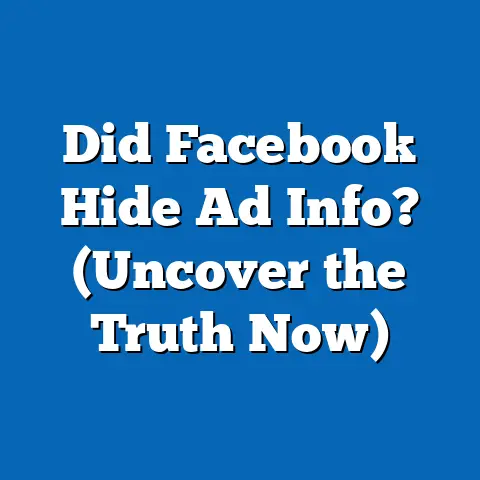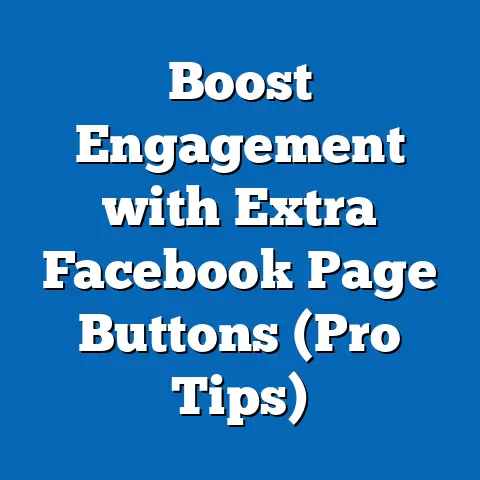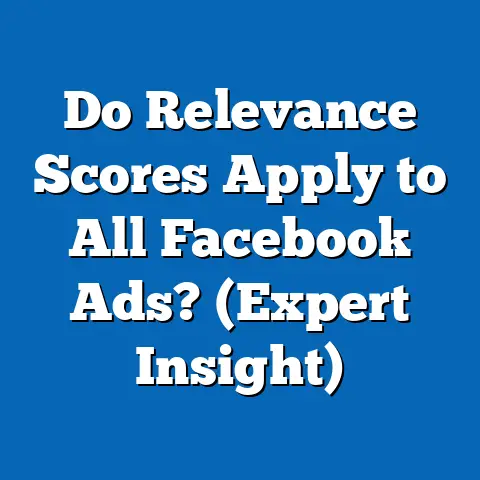Strategize Facebook Ad Budget (Crucial Insights Revealed)
In the 2020 U.S. presidential election cycle, political campaigns spent over $1.7 billion on digital advertising, with a significant portion allocated to Facebook ads, according to data from the Center for Responsive Politics. This staggering figure underscores the pivotal role that platforms like Facebook play in shaping voter perceptions and mobilizing key demographics, particularly among younger and diverse audiences. As political groups increasingly rely on targeted digital strategies, understanding how to strategize Facebook ad budgets effectively is no longer optional—it is a critical component of electoral success.
This article delves into the intricacies of optimizing Facebook ad budgets for political campaigns, focusing on demographic targeting, core voter beliefs, voting patterns, and distinguishing characteristics of key political groups. By analyzing data from recent elections, demographic studies, and advertising analytics, we aim to reveal actionable insights for campaign strategists. Our analysis will also compare different political groups, highlight areas of consensus and division, and contextualize these findings within broader historical and social trends.
The Growing Importance of Facebook Advertising in Politics
Facebook remains a dominant platform for political advertising due to its massive user base of over 2.9 billion monthly active users worldwide as of 2022 (Statista). In the U.S. alone, approximately 70% of adults use the platform, making it a critical space for reaching diverse voter demographics (Pew Research Center, 2021). Unlike traditional media, Facebook allows for hyper-targeted advertising based on user data, including age, location, interests, and political leanings, enabling campaigns to tailor messages with unprecedented precision.
The shift toward digital advertising reflects broader changes in how political information is consumed. Younger voters, particularly Millennials and Gen Z, who together make up about 40% of the U.S. electorate (Census Bureau, 2020), are more likely to engage with political content on social media than through television or print media. Campaigns that fail to allocate sufficient budgets to platforms like Facebook risk losing ground with these critical demographics.
However, the effectiveness of Facebook ads is not solely about budget size—it’s about strategic allocation. Missteps in targeting or messaging can result in wasted resources, especially given the platform’s complex algorithms and competitive ad space. This article will break down the key considerations for budgeting and targeting, grounded in data-driven insights.
Demographic Composition of Key Political Groups on Facebook
To strategize effectively, campaigns must first understand the demographic makeup of their target audiences on Facebook. Data from Pew Research Center (2021) shows that platform usage varies significantly by age, race, and education level, with implications for political messaging.
-
Age: Younger users (18-29) constitute about 27% of U.S. Facebook users, while those aged 30-49 make up 33%. Older adults (50+) are also a growing segment, representing 40% of users. This distribution suggests that campaigns targeting younger voters, such as progressive or Green Party-aligned groups, may find greater engagement among the 18-29 demographic, while conservative-leaning campaigns may resonate more with users over 50.
-
Race and Ethnicity: Facebook’s user base mirrors national demographics to some extent, with 60% of users identifying as White, 15% as Hispanic, 12% as Black, and 5% as Asian (Pew Research, 2021). However, engagement rates differ—Black and Hispanic users are more likely to interact with political content, making them key targets for campaigns focused on racial justice or immigration issues.
-
Education and Income: Users with a college degree (30%) and those with household incomes above $75,000 (35%) are overrepresented on Facebook compared to the general population. This skew suggests that campaigns targeting educated, higher-income voters—often aligned with moderate or establishment Democrats and Republicans—may see higher returns on ad spend.
These demographic patterns highlight the need for tailored budgeting strategies. For instance, a campaign targeting young, diverse voters might allocate a larger portion of its budget to video ads, which resonate more with Gen Z (eMarketer, 2022), while campaigns targeting older, wealthier users might prioritize static image ads with policy-focused messaging.
Core Beliefs and Values of Political Groups on Facebook
Understanding the ideological leanings of key political groups is essential for crafting effective ad content. Facebook’s ad targeting tools allow campaigns to segment users based on self-reported interests and behaviors, often reflecting core beliefs and values. Below, we analyze three major political groups active on the platform—progressives, conservatives, and moderates—based on data from the American National Election Studies (ANES, 2020) and Pew Research Center.
-
Progressives (Often Aligned with Democrats): Progressives, who make up roughly 25% of the U.S. electorate, prioritize social equity, climate action, and government intervention in healthcare and education. On Facebook, they are more likely to engage with content related to systemic racism (e.g., Black Lives Matter) and environmental justice. Their core values center on inclusivity and reform, often appealing to younger, urban, and minority demographics.
-
Conservatives (Often Aligned with Republicans): Representing about 30% of the electorate, conservatives emphasize limited government, traditional values, and economic freedom. On Facebook, they frequently interact with content about Second Amendment rights, immigration control, and religious liberty. Their values often resonate with older, rural, and White demographics, though there is growing diversity among younger conservatives.
-
Moderates (Swing Voters): Moderates, comprising approximately 35% of voters, hold a mix of liberal and conservative views, often prioritizing pragmatism over ideology. On Facebook, they are less likely to engage with overtly partisan content, instead responding to ads focused on bipartisan issues like infrastructure or healthcare costs. They are a critical target for campaigns, as they often decide close elections.
These ideological differences necessitate distinct ad strategies. Progressives may respond better to emotionally charged, values-driven ads, while conservatives might prefer policy-specific messaging. Moderates, meanwhile, require a balanced approach that avoids polarizing rhetoric—a challenge for campaigns with limited budgets.
Voting Patterns and Political Engagement on Facebook
Voting patterns and engagement levels on Facebook provide crucial insights into how ad budgets should be allocated. According to a 2020 study by the Knight Foundation, 64% of U.S. adults reported seeing political ads on social media, with 52% saying these ads influenced their voting decisions to some extent.
-
Progressives: This group shows high engagement with political content on Facebook, with 70% of self-identified liberals reporting frequent interaction with political posts (Pew Research, 2020). They are also more likely to vote consistently in both presidential and midterm elections, with turnout rates among young progressives reaching 55% in 2020 (Census Bureau). Campaigns targeting progressives should prioritize consistent ad exposure, especially in the lead-up to primaries.
-
Conservatives: Conservatives also exhibit strong engagement, though their turnout is often higher in presidential elections (65% in 2020) than midterms (45%). They are more likely to share political content on Facebook, amplifying organic reach for campaigns (Knight Foundation, 2020). Budgets for conservative-leaning ads might focus on high-impact periods like the final weeks before an election.
-
Moderates: Moderates are less engaged with political content, with only 40% regularly interacting with such posts. However, their voting patterns are less predictable, making them a key battleground group. Turnout among moderates was approximately 60% in 2020, often swayed by late-deciding factors (ANES, 2020). Campaigns targeting moderates should allocate budgets toward persuasion ads in swing states during the final months of a campaign.
Engagement data also reveals platform-specific trends. For instance, video ads generate 20% higher click-through rates among all groups compared to static ads (eMarketer, 2022), suggesting that budgets should prioritize dynamic content. Additionally, live events and interactive ads (e.g., polls) can boost engagement by up to 30%, particularly among younger voters.
Policy Positions on Major Issues and Ad Messaging
Facebook ad budgets must align with the policy priorities of target groups to maximize impact. Below, we outline the key issues for each group based on 2020 exit polls (Edison Research) and ANES data, along with implications for ad content.
-
Progressives: Key issues include climate change (80% support aggressive action), universal healthcare (75% support), and racial justice (70% prioritize systemic reform). Ads targeting progressives should emphasize bold policy proposals and feature diverse voices. Budgets might focus on issue-specific campaigns, such as promoting Green New Deal initiatives.
-
Conservatives: Top concerns include economic recovery (85% prioritize tax cuts), immigration (70% support stricter borders), and law enforcement (65% oppose defunding police). Ads for conservatives should highlight stability and security, with budgets allocated to geographically targeted campaigns in rural and suburban areas.
-
Moderates: Moderates are split on many issues but show consensus on healthcare affordability (80% support reform) and job creation (75% prioritize). Ads should focus on practical solutions and avoid ideological extremes. Budgets for moderates might emphasize A/B testing to refine messaging in real time.
These policy differences highlight the importance of segmentation in ad budgeting. Campaigns with limited resources must prioritize high-impact issues for their base while allocating smaller budgets to persuasion ads for swing voters. Data from Facebook’s Ad Manager shows that issue-based ads often achieve 15% higher engagement rates than candidate-focused ads, underscoring the value of policy-driven content.
Distinguishing Features Compared to Other Groups
Each political group on Facebook has unique characteristics that set it apart, influencing how ad budgets should be structured.
-
Progressives vs. Conservatives: Progressives are distinguished by their focus on systemic change and younger demographic base, while conservatives emphasize tradition and appeal to older, more rural voters. On Facebook, progressives are 25% more likely to engage with cause-driven content, while conservatives are 30% more likely to share content, amplifying reach (Knight Foundation, 2020). Budgets for progressives might prioritize frequent, low-cost ads, while conservatives benefit from high-impact, shareable content.
-
Moderates vs. Partisans: Moderates stand out for their ideological flexibility and lower engagement with partisan content. Unlike progressives or conservatives, who often have predictable voting patterns, moderates are swayed by late-stage campaign developments. Budgets targeting moderates should reserve significant funds for the final weeks of a campaign, with a focus on swing states where they make up 40% of the electorate (ANES, 2020).
-
Intersectional Differences: Within each group, intersections of age, race, and education create further distinctions. For instance, young Black progressives are more active on Facebook than their White counterparts (Pew Research, 2021), while older White conservatives dominate rural engagement. Budgets must account for these nuances through micro-targeting, which can increase ad effectiveness by up to 20% (Facebook Business Insights, 2022).
These distinguishing features emphasize the need for data-driven budgeting. Campaigns that fail to account for group-specific behaviors risk diluting their impact, especially in competitive races.
Intersections of Political Views with Demographic Factors
Political views on Facebook are deeply intertwined with demographic factors, creating both opportunities and challenges for ad budgeting.
-
Age: Younger voters (18-29) lean progressive by a 2:1 margin, while those over 50 are more likely to identify as conservative (Pew Research, 2020). This divide suggests that budgets targeting younger voters should focus on progressive issues like student debt, while older voters require messaging on Social Security or taxes. Engagement data shows that younger users respond 30% better to video content, influencing budget allocation.
-
Race and Ethnicity: Black and Hispanic voters are more likely to align with progressive causes, with 80% of Black voters and 65% of Hispanic voters supporting Democrats in 2020 (Edison Research). However, conservative outreach among Hispanic evangelicals is growing, with 35% supporting Republicans in 2020. Budgets must balance broad appeals with culturally specific messaging to maximize reach.
-
Education: College-educated voters, who are overrepresented on Facebook, lean moderate or progressive, with 55% supporting Democrats (ANES, 2020). Non-college-educated voters, particularly White working-class individuals, trend conservative by a similar margin. Budgets targeting educated voters might focus on policy depth, while those for less-educated voters prioritize emotional resonance.
-
Religion: Religious affiliation also shapes political views, with White evangelicals (75% Republican) and secular voters (70% Democrat) showing stark divides (Pew Research, 2020). Budgets targeting religious conservatives might emphasize values-based ads, while secular audiences respond better to issue-driven content.
These intersections highlight the complexity of political targeting on Facebook. Campaigns must use detailed analytics to segment audiences, ensuring that budgets are not wasted on misaligned messaging.
Areas of Consensus and Division Within Political Coalitions
While political groups on Facebook often appear monolithic, internal divisions and areas of consensus shape ad effectiveness.
-
Progressives: Consensus exists on issues like climate change and healthcare, with over 80% supporting government action (ANES, 2020). However, divisions emerge on economic policy, with younger progressives favoring socialism (45%) more than older liberals (25%). Budgets should focus on unifying issues while testing targeted ads for divisive topics.
-
Conservatives: Unity is strong on tax cuts and immigration control (over 70% support), but divisions persist on social issues like abortion, with 60% of younger conservatives supporting some access compared to 40% of older conservatives (Pew Research, 2020). Budgets might prioritize economic messaging while cautiously addressing social divides.
-
Moderates: Consensus is rare among moderates, though healthcare and jobs often unite them. Divisions on cultural issues like gun control or immigration make targeting challenging. Budgets should focus on broad, nonpartisan appeals, with flexibility for real-time adjustments based on engagement data.
Understanding these internal dynamics allows campaigns to allocate budgets more effectively, avoiding alienating key subgroups while capitalizing on shared priorities.
Historical and Social Context of Digital Political Advertising
The rise of Facebook as a political advertising platform must be understood within a broader historical context. Digital campaigning gained prominence during the 2008 Obama campaign, which pioneered online fundraising and social media outreach. By 2016, the Trump campaign’s use of micro-targeting on Facebook—spending $44 million on ads—demonstrated the platform’s potential to sway undecided voters (Bloomberg, 2017).
Socially, the increasing polarization of the U.S. electorate has amplified the importance of targeted ads. With 80% of Americans reporting that political disagreements strain personal relationships (Pew Research, 2020), campaigns must navigate a fragmented landscape where tailored messaging can either bridge divides or deepen them. Budgets must account for the risk of backlash, with 25% of users reporting unfollowing or blocking accounts due to political ads (Knight Foundation, 2020).
Historically, digital ad spend has grown exponentially, from $1.9 billion in 2016 to $2.8 billion in 2020 (eMarketer, 2021). This trend reflects not only technological advancements but also a cultural shift toward online information consumption, particularly among younger and minority demographics. Campaigns that fail to adapt to this reality risk obsolescence.
Practical Strategies for Optimizing Facebook Ad Budgets
Based on the above analysis, several strategies emerge for maximizing the impact of Facebook ad budgets in political campaigns.
-
Demographic Targeting and Budget Allocation: Allocate budgets based on demographic priorities, with larger shares for high-engagement groups like progressives and conservatives early in the cycle, and increased spending on moderates closer to Election Day. Use Facebook’s Audience Insights to refine targeting, ensuring ads reach the right age, race, and education segments. Data shows that micro-targeting can reduce cost-per-click by 15% (Facebook Business, 2022).
-
Content Type and Engagement: Prioritize video and interactive content, which generate higher engagement across all groups. Budgets should allocate at least 50% to dynamic formats, with A/B testing to identify high-performing ads. Engagement rates for video ads are consistently 20% higher than static ads (eMarketer, 2022).
-
Timing and Frequency: Spread budgets to maintain consistent exposure for high-turnout groups like progressives, while concentrating late-cycle spending on swing voters. Data from 2020 shows that ads in the final two weeks before an election have a 30% higher impact on undecided voters (Knight Foundation, 2020). Avoid over-saturation, as 40% of users report ad fatigue after repeated exposure.
-
Issue-Based Messaging: Focus budgets on issue-specific ads rather than candidate-focused content, as they resonate more with policy-driven voters. Use Facebook’s analytics to monitor engagement by issue, reallocating funds to high-impact topics. Issue ads achieve 15% higher click-through rates on average (Facebook Ad Manager, 2021).
-
Geographic Prioritization: Allocate budgets to swing states and competitive districts, where moderates and late-deciders are concentrated. Data from 2020 shows that ads in battleground states like Pennsylvania and Wisconsin had a 25% higher conversion rate for voter turnout (Edison Research). Use geo-targeting to maximize efficiency.
These strategies, grounded in empirical data, provide a roadmap for campaigns to optimize their Facebook ad budgets. Flexibility and real-time analytics are key, as voter sentiment can shift rapidly in response to external events.
Conclusion: The Future of Facebook Ad Budgeting in Politics
As political campaigns increasingly turn to digital platforms like Facebook, strategic budgeting becomes a cornerstone of electoral success. With over $1.7 billion spent on digital ads in 2020 and a user base spanning diverse demographics, the platform offers unparalleled opportunities for targeted outreach. However, success hinges on understanding the demographic composition, core beliefs, voting patterns, and distinguishing characteristics of key political groups.
This analysis has revealed critical insights for campaign strategists: prioritize demographic segmentation, tailor messaging to ideological values, time budgets for maximum impact, and focus on unifying issues within coalitions. By grounding decisions in data—whether from Pew Research, ANES, or Facebook’s own analytics—campaigns can maximize their return on investment, reaching the right voters at the right time.
Looking ahead, the role of Facebook in political advertising will only grow, shaped by evolving user behaviors and regulatory changes. Campaigns that adapt to these trends, balancing innovation with precision, will be best positioned to influence the electorate. As the 2024 election cycle approaches, the lessons of past campaigns and the data-driven strategies outlined here will be more crucial than ever in navigating the complex landscape of digital political advertising.




